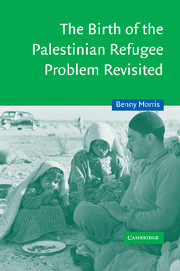Book contents
- Frontmatter
- Contents
- Acknowledgements
- Map 1 The United Nations Partition Plan, November 1947
- Map 2 Arab settlements abandoned in 1948–9
- Map 3 Jewish settlements established in 1948–9
- List of abbreviations
- Introduction to the revised edition
- 1 Background: a brief history
- 2 The idea of ‘transfer’ in Zionist thinking before 1948
- 3 The first wave: the Arab exodus, December 1947 – March 1948
- 4 The second wave: the mass exodus, April–June 1948
- 5 Deciding against a return of the refugees, April–December 1948
- 6 Blocking a return
- 7 The third wave: the Ten Days (9–18 July) and the second truce (18 July–15 October)
- 8 The fourth wave: the battles and exodus of October–November 1948
- 9 Clearing the borders: expulsions and population transfers, November 1948–1950
- 10 Solving the refugee problem, December 1948 – September 1949
- Conclusion
- Appendix 1
- Appendix 2
- Bibliography
- Index
- Titles in the series
10 - Solving the refugee problem, December 1948 – September 1949
Published online by Cambridge University Press: 05 June 2012
- Frontmatter
- Contents
- Acknowledgements
- Map 1 The United Nations Partition Plan, November 1947
- Map 2 Arab settlements abandoned in 1948–9
- Map 3 Jewish settlements established in 1948–9
- List of abbreviations
- Introduction to the revised edition
- 1 Background: a brief history
- 2 The idea of ‘transfer’ in Zionist thinking before 1948
- 3 The first wave: the Arab exodus, December 1947 – March 1948
- 4 The second wave: the mass exodus, April–June 1948
- 5 Deciding against a return of the refugees, April–December 1948
- 6 Blocking a return
- 7 The third wave: the Ten Days (9–18 July) and the second truce (18 July–15 October)
- 8 The fourth wave: the battles and exodus of October–November 1948
- 9 Clearing the borders: expulsions and population transfers, November 1948–1950
- 10 Solving the refugee problem, December 1948 – September 1949
- Conclusion
- Appendix 1
- Appendix 2
- Bibliography
- Index
- Titles in the series
Summary
THE PALESTINE CONCILIATION COMMISSION AND LAUSANNE I: STALEMATE
International efforts at the end of 1948 and during the first half of 1949 to solve the refugee problem proceeded along two crisscrossing avenues – one, as conducted by agencies of the United Nations, primarily the Palestine Conciliation Commission (PCC), and the other, as conducted by the Great Powers, meaning, primarily, the United States. Both sets of efforts were guided in large measure by Bernadotte's testament, the interim report of mid-September 1948, and its ‘doctrinal’ postulate that the right of the refugee to return to his home and land was absolute and should be recognised by all parties. This postulate was enshrined two months after the Mediator's death in UN General Assembly Resolution 194, of 11 December 1948. The resolution stated that ‘the refugees wishing to return to their homes and live at peace with their neighbours should be permitted to do so at the earliest practicable date’. (The resolution also offered those ‘choosing not to return’ the alternative of ‘compensation’.) The PCC, set up by the resolution, was instructed to facilitate the ‘repatriation’ of those wishing to return.
The absolute nature of the return provision was immediately and almost universally qualified, in the minds of Western observers, by the appreciation that Israel would not allow a mass return and that many refugees might not wish to return to live under Jewish rule.
Information
- Type
- Chapter
- Information
- The Birth of the Palestinian Refugee Problem Revisited , pp. 549 - 587Publisher: Cambridge University PressPrint publication year: 2003
